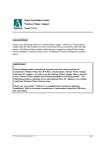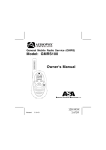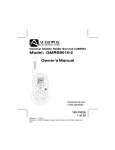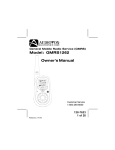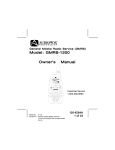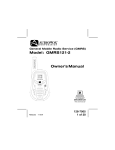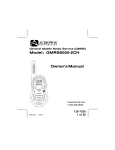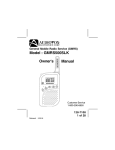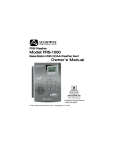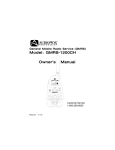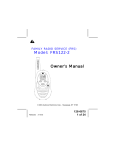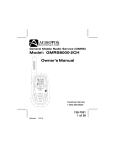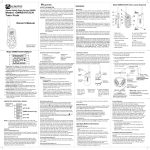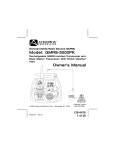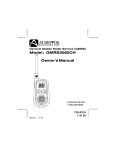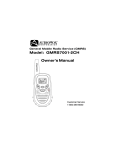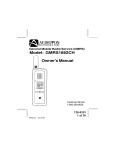Download Audiovox GMRS200 User's Manual
Transcript
General Mobile Radio Service (GMRS) Model: GMRS200 Owner's Manual Released: 3- 03 - 2005 128-XXXX 1 of 24 THIS PAGE LEFT BLANK INTENTIONALLY 2 128-xxxx 2 of 28 CAUTION SAFETY INFORMATION Your wireless hand-held portable transceiver contains a low power transmitter. When the PTT button is pushed (or the VOX mode is enabled) it sends out radio frequency (RF) signals. The device is authorized to operate at a duty factor not to exceed 50%. In August 1996, the Federal Communications Commissions (FCC) adopted RF exposure guidelines with safety levels for hand-held wireless devices. Important: To maintain compliance with the FCC’ s RF exposure guidelines hold the transmitter at least 1 inch (2.5 centimeters) from your face and speak in a normal voice, with the antenna pointed up and away. If you wear the handset on your body while using the headset accessory, use only the Audiovox supplied carry clip for this product and ensure that the antenna is at least 1 inch (2.5 centimeters) from your body when transmitting. Use only the supplied antenna. Do not use your transceiver with a damaged antenna. Unauthorized antennas, modifications, or attachments could damage the transmitter and may violate FCC regulations. Performance: Your transceiver will only achieve its maximum operating range when communicating with other transceivers across open and flat areas or between elevated points. Normally occurring environmental factors such as buildings, trees, terrain and weather, or interference from other radio or electrical equipment, may have adverse effects on the transceiver’s effective range. These are not indicative of a fault condition. Avoid placing the GMRS200 radio transceiver for prolonged periods of time in direct sunlight or temperatures below -4° F(-20 ° C) or above 140°F (60°C). Place the rubber cover on jacks when not in use. 3 128-xxxx 3 of 28 WARNINGS: Battery Care Never attempt to charge alkaline or dry cell batteries, as batteries may burst causing personal injury and damage to the product. If rechargeable batteries are used, such as Nickel Metal Hydride (NiMH), use only Audiovoxapproved rechargeable batteries. Use of the optional Audiovox charger with other brands of batteries is not recommended, as battery charging times will vary with different brands. Refer to the Manufacturer’s instructions for charging other brands of batteries. Battery Disposal In general, if handled improperly, batteries pose a risk of fire or burns. Do not disassemble, crush, puncture, short external contacts, or dispose of the batteries in fire or water. Dispose of the batteries in a environmentally safe manner and recycle whenever possible. FCC WARNING Replacement or substitution of transistors, diodes or other parts of a unique nature, with parts other than those recommended by the manufacturer, may cause a violation of the technical regulations of Part 15 of FCC Rules. GMRS LICENSE: USE OF THIS RADIO WITHIN THE UNITED STATES REQUIRES AN FCC GMRS LICENSE. AN INDIVIDUAL 18 YEARS OF AGE OR OLDER, WHO IS NOT A REPRESENTATAIVE OF A FOREIGN GOVERNMENT, IS ELIGIBLE TO APPLY FOR A GMRS SYSTEM LICENSE. YOU WILL NEED TWO FORMS FROM THE FCC: FCC FORM 159, AND FCC FORM 605 (MAIN FORM AND SCHEDULE F). YOU CAN FIND THE FORMS ONLINE AT: HTTP://WWW.FCC.GOV/FORMPAGE.HTML, OR CALL 1-800-418-3676. 4 128-xxxx 4 of 28 Model GMRS200 (FCC License Required) 6 3 (REF) 5 8 4 10 PTT- M- 3 11 12 13 2 9 7 1 1 (REF) 1. 2. 3. 4. Battery Cover Keylock/Monitor (M) Button Detachable Carry Clip Push-To-Talk (PTT) and Function Confirmation Button 5. Antenna 6. External Speaker (SP)/ Microphone (MIC)/CHG Jack 7. Built-in Speaker 14 8. Liquid Crystal Display (LCD) 9. Built-in Microphone 10. Up Channel/Volume Button 11. Down Channel/Volume Button 12. MODE/Weather Button 13. Power On/Off and SCAN Button 14. Battery Charging Contacts 5 128-xxxx 5 of 28 Model GMRS200 DISPLAY 1 8 2 9 3 HI LO BUSY 4 10 11 12 5 13 6 14 7 1. Beep Tone Indicator: Icon appears when beep button confirmation tone is selected; icon disappears when tone is off. 2. Key Lock Indicator: Icon appears when the keypad is locked. This function disables keys such as channel up/down, SCAN and MODE. 3. Monitor Indicator: Icon appears when the Monitor (M) button is pressed and the channel monitor function is activated. 4. Signal Strength Indicator: Icon appears when a signal is being transmitted. The icon consists of five bars to indicate transmit signal power level. 5. HI/LO Indicators: Power level indicator appears when the transmit power is set to desired output power on the GMRS channels. 6. Large Segment Display: Indicates the channel number in use. 7. Scan Indicator: This function allows the user to scan a channel (and tone code, if present) every .5 second to search for a valid signal. 8. RogerBeep Tone On/Off Indicator: This icon appears when the Roger Beep tone is on, and disappears when tone is not in use. 9. Battery Level Indicator: Icon indicates the battery charge level. 10.Signal Receive Indicator: BUSY icon appears when a signal is being received. 11. Weather Mode Indicator: Icon will be on steady when in the weather band mode. When in the GMRS/FRS mode, the icon will blink when the alert is active 6 128-xxxx 6 of 28 12.Small Segment Display: Displays the CTCSS tone option for each main channel from 01-38. 13.Dual Watch Mode Indicator: Indicator appears when dual watch mode is active. 14.Voice Activated Transmission (VOX) Indicator: This function allows hands free conversation. The indicator appears when the VOX mode is activated. Equipment and Accessories Supplied 1. 2. 3. Radio (4) Owner’s Manual (1) Rechargeable Batteries (4) GMRS200 128-XXXX NiMH, 1.2V, 900mAh, Optional Accessories 1. 2. Boom Microphone/Headset Leather Carrying Case GMRSBHST4 GMRS1502LC Powering the transceiver: Your GMRS200 radio transceiver operates on four rechargeable batteries. Only approved rechargeable batteries can be recharged in the GMRS4WM wall mount charger. This will ensure optimum performance for the GMRS200. Battery charging time is typically 10-12 hours. Use of other brands of rechargeable batteries is not recommended as battery charging time will vary. Do not mix old and new, or batteries of differing manufacture, since the charging will be uneven and will result in decreased battery life. If necessary, four AAA alkaline batteries can be used to power the GMRS200, but note that these type batteries can not be recharged and damage to the charger or the batteries may result if the units are placed in the GMRS4WM wall mount charger with the alkaline batteries installed. FOR THIS REASON, IT IS NOT RECOMMENDED TO USE ALKALINE BATTERIES IN THE GMRS200. DO NOT PLACE GMRS200 TRANSCEIVERS IN THE CHARGING STAND IF THERE ARE ALKALINE BATTERIES INSTALLED. 7 128-XXXX 7 of 24 Installing the batteries: Battery installation is made more convenient when the carry clip is either rotated left or right to the horizontal position, or is removed. Simply rotate the clip in either direction to the horizontal position. Be careful not to use excessive force. To remove the clip, press down on the spring release tab and pull the clip straight out from the radio body. Next, press down with the thumb at the embossed arrow, slide the battery cover down and lift it away from the compartment. Insert four AAA batteries (alternate positive ends (+) toward the top of the transceiver, starting left-to-right. CLIP SPRING RELEASE TAB COVER ARROW CARRY CLIP + + BATTERY COVER 1. Using thumb, press down on battery cover at arrow and slide cover down. 2. Then lift cover at bottom to open. Remove cover. POSITIVE TERMINALS + + 3. Insert four AAA batteries (positive (+) end toward the top begining at left side and alternating positive terminals as shown). 8 128-XXXX 8 of 24 The following guidelines will improve performance and provide longer operating times for the GMRS200: 1. Do not mix old and new batteries. 2. Do not mix alkaline, standard (carbon-zinc) or rechargeable batteries. 3. If the unit is not to be used for an extended period of time, remove the batteries. Old or leaking batteries can cause damage to the unit and will void the warranty. MIC/CHG/ SPK JACK GMRS200 NOTE: Only Audiovox approved rechargeable batteries (Ni-MH,900mA,1.2V) can be recharged in the radio transceiver. 9 128-xxxx 9 of 24 GMRS200 OPERATIONAL MODES GMRS/FRS BAND WEATHER BAND CHANNEL SELECT CHANNEL SELECT CTCSS SELECT WEATHER Alert SELECT POWER SELECT NOTE: 1. To switch between GMRS/FRS and Weather Band modes, press and hold the Mode button for 3 seconds. Refer to the appropriate section of this manual for detailed operating instructions for each mode. (GMRS Channels Only) VOX LEVEL SELECT DUAL WATCH BUTTON BEEP ROGER BEEP CALL SELECT Controls: Power On-Off/SCAN Button (13) Press and hold the PWR on/off button for at least 2 seconds. You will hear a confirming melody to indicate the unit is on. To turn the unit off, press and hold the button for at least 2 seconds. Press this Button momentarily to enable or disable the scan mode. 10 128-xxxx 10 of 28 Adjusting the Volume (11, 10) With the unit powered on, press the Up Channel/Volume button ( ) to increase volume and the Down Channel/Volume button ( ) to decrease volume. The display will indicate the current volume level between 1 and 7 by the small number in the icon ( UL 5 ). Monitor/Keylock Button (2) This button is used to check activity on the current frequency before transmitting. Check activity by pressing the Monitor (M) Button longer icon will apppear on the display and you will than 2 seconds; the hear static if frequency is clear. Do not transmit if you hear conversation. Hold down the Monitor Button again longer than 2 seconds and the icon will disapppear from the display. The monitor function will temporarily bypass the squelch setting and play all signals on a given channel. This feature is useful when communicating with other parties at extreme range. By pressing the monitor button momentarily, the keylock icon ( ) will appear to confirm the functions MODE, SCAN and channel up/down button s have been disabled. Push To Talk (PTT) Button (4) Pressing and holding this button will allow you to speak to any transceiver that is set to the same channel and privacy code setting as yours. Hold the transceiver approximately 1 to 2 inches from your face as you speak into the built in microphone (9). After you have finished speaking, release the PTT Button to allow reception of incoming signals. It is not possible to transmit and receive at the same time. The Transmit Signal Level indicator ( ) will display the relative strength of the transmitted signal. When receiving an incoming signal, the BUSY icon will appear in the upper right quadrant of the display. The PTT button can also be used as a two-way call ringer. Pressing the button twice quickly will call another party on the same channel. 11 128-xxxx 11 of 28 Up Channel/Volume Button (10) In the standby mode, pressing this button will increase the listening volume. When in function edit mode this button will be used to adjust the unit’s settings. Down Channel/Volume Button (11) In the standby mode, pressing this button will decrease the listening volume. When in function edit mode this button will be used to adjust the unit’s settings. Mode Button (12) This button is used to select the various feature settings in the GMRS/FRS or Weather band modes. Holding the MODE button longer than 2 seconds will toggle between the GMRS/FRS and Weather band modes. External Microphone (MIC)/Speaker (SPK)/(CHG) Jack (6) This jack accepts an Audiovox Earbud/microphone connector, or the Charging Adapter connector. For equipment and accessories, refer to Page 7 and/or visit the Audiovox web site at www.audiovox.com Operating Modes and Features GMRS Operation: - From GMRS/FRS standby mode, press and hold the ( ) button for more than 2 second to turn on power . - Press the MODE button so the Channel number flashes. - Select the desired channel with the Up (10) and Down (11) Buttons. When receiving a call, the BUSY icon appears to indicate the incoming signal. - Press and hold the PTT button (4) to transmit, then speak into the microphone clearly and slowly. The Transmit Signal Level indicator ( ) will display the relative strength of the transmitted signal. 12 128-xxxx 12 of 28 - Release PTT Button (4) to receive. - Communication can only be accomplished when the channel and CTCSS tone frequency of at least two parties are the same. - The CTCSS small segment display will appear next to the main frequency channel on the display if the CTCSS tone frequency function is enabled. Channel Selection In order to communicate with other GMRS units, both transmitting and receiving party must be on the same frequency. The GMRS200 has 22 channels (frequencies) indicated by the large digits on the LCD display panel. Channels 1 through 7 are the shared GMRS/FRS channels. Channels 8-14 are FRS only channels, while channels 15-22 are assigned GMRS only channels. If an FRS only channel (8-14) has been selected, the HI or LO indicator will not be displayed on the LCD panel; otherwise, for channels 1-7 (GMRS/FRS) and 15-22 (GMRS only), the HI or LO indicator will be displayed. Communication with Audiovox FRS and compatible units is possible on the shared and FRS only channels. Before transmitting on the selected channel, press the Monitor (M) Button (2) to check the activity on that channel. If there is activity on the selected channel, change to another channel that is clear. To change the channel: - From GMRS/FRS standby mode, press the MODE button (12) once or until the channel number flashes. - Press the Up Button (10) briefly to move to the next higher main channel number. - Press the Down Button (11) briefly to move to the next lower main channel number. - Press the PTT button momentarily to confirm selection. CTCSS Mode (Sub-Channel) Selection The Coded Tone Controlled Squelch System (CTCSS) provides 38 Sub-Frequencies. This feature allows you to utilize the coded squelch tones (01– 38) within a main channel, and enables you to communicate with another 13 128-xxxx 13 of 28 party on the same main channel using the same subcode. (This filters out unwanted transmissions without the same coded squelch tone). There are 38 CTCSS Sub-channels for each main channel. A different subcode may be selected for each of the 22 channels. To change the CTCSS Sub-channel: - From GMRS/FRS standby mode, press the MODE Button twice; a flashing oF or sub-channel number is displayed. If oF is displayed, press the Up or Down button to enable the CTCSS mode. - Then press the Up or Down button to select the desired sub-channel for use (01-38). - Press the PTT button momentarily to confirm selection. The CTCSS mode can be turned off by selecting the oF icon as the setting. NOTE: To communicate with other GMRS/FRS units, they must be switched to the same channel and CTCSS subcode. To communicate with other GMRS/FRS units that do not have subcodes, switch your unit to the same channel with the subcode set to oF. The CTCSS subcodes do not prevent others from hearing your transmission. This will only allow you to ignore all traffic on a given channel not using the same subcode. Transmit Power Selection Mode This feature permits selection of the transmitting power level to high or low. When operating on FRS only channels (8-15), no power selection is possible or is displayed. Using low power, the unit will have a lower transmit range, but battery life will be increased. To access the transmitter power selection function: - From GMRS/FRS standby mode (shared channels 1-7 or GMRS only channel (15-22) selected), press the MODE Button three times until the power HI or Lo indication appears with a flashing Po indication on the display. - Press the Up or Down button to toggle between the High and Low selections. - Press the PTT button momentarily to confirm selection. 14 128-xxxx 14 of 28 VOX and Sensitivity Level Selection This selection enables you to set the VOX function and its sensitivity level to compensate for ambient noise in your immediate area. A VOX sensitivity of 3 is the most sensitive, and should be used in a relatively quiet surrounding. A VOX sensitivity of 1 is the least sensitive and should be used in a noisy surrounding. To set the VOX sensitivity level: - Press the MODE button 4 times (3 times for FRS) until the VO icon appears on the display accompanied by the flashing VOX icon and the numeral 1, 2 or 3 and off. - Press the Up or Down button to select the 1-3 VOX level sensitivity. - Press the PTT button momentarily to confirm the VOX selection. - The VOX icon will disappear from the display unless VOX mode is enabled(off). Dual Watch Mode This feature allows you to monitor two channels at the same time. While in dual watch mode, the unit will continuously monitor both the primary and dual watch channel. Received signals will be played for 5 seconds, then the unit will resume scanning the two channels. Pressing the PTT button during a received transmission will set the unit to transmit on the same channel. Pressing the PTT button when no signal is received will set the unit to transmit on the primary channel. To set the Dual Watch Mode: - From GMRS/FRS standby mode, press the MODE button 5 times (4 times for FRS); DW appears flashing on the display. If the dual watch mode is off, the oF icon will also appear flashing. - To enable the dual watch mode, press the Up or Down button; the dual watch channel number will flash and start to increase or decrease as the Up or Down button is pressed. - To select a subcode for the dual watch channel, press the MODE button while the selected dual watch channel is flashing. Then use the Up and Down buttons to select the desired CTCSS subcode. 15 128-xxxx 15 of 28 - Press the PTT button momentarily to confirm selection of the dual watch channel. The display will now alternate between the primary channel and the dual watch channel just selected. NOTE: Pressing the PTT button during dual watch mode will transmit on the primary channel and suspend dual watch operation for 20 seconds. Dual watch mode will then resume. - Momentarily press the SCAN button to exit the dual watch mode. Key Tone This feature allows the transceiver to sound a confirmation tone whenever the following keys are pressed: Monitor (M) Button, Up/Down Buttons, MODE Button or SCAN Button. To turn the key tones on or off: - From GMRS/FRS standby mode, press the MODE Button 6 times (5 times for FRS) until the Bell ( ) icon flashes, and on or oF appears on the display. - Press the Up or Down Button to toggle the key tone feature On or Off. - Press the PTT button momentarily to confirm selection. When the key tone feature is on, the Bell icon appears steady on the display, and the beep tones sound in response to button activation. Roger Beep Tone The Roger Beep is a tone which is automatically transmitted whenever the PTT button is released. This tone alerts the receiving party that the transmission has been terminated intentionally. To enable and disable the Roger Beep tone: - From GMRS/FRS standby mode, press the MODE Button 7 times (6 times for FRS) until the flashing Roger Beep icon ( ) and on or oF appears on the display. - Press the Up or Down button to select the tone on or off as desired. - When enabled, the tone icon ( 16 128-xxxx 16 of 28 Call Ringer Selection Mode The transceiver provides 3 user-selectable call ringer melodies to alert you to an incoming call. To select your favorite call ringer melody: - From GMRS/FRS standby mode, press the MODE Button 8 times (7 times for FRS). CA will appear on the display, together with a flashing number between 01 and 03, and an appropriate call ring. - Press the Up or Down Button to preview and hear the 3 available call melodies. - Press the PTT button momentarily to confirm selection. Channel Scan Operation This feature allows you to monitor all channels automatically for valid signals. While scanning, you can transmit and receive. When a signal is received, the scan is interrupted and will return to scan mode 5 seconds after reception is terminated. NOTE: While the scan function is active, the MODE button will be inoperative. The scan mode will reduce the overall battery life since the battery save function is overridden. To enable the channel scan mode: - From GMRS/FRS standby mode, momentarily press the SCAN But ton; (SCAN) will appear on the LCD display. - The radio will display each channel (1-22) in ascending order as the scan mode operates to find an active main channel. - If the unit doesn’t find any signals and you want to transmit, press the PTT button to return to home channel operation. The transceiver will automatically resume scanning approximately 5 seconds after the communication is completed. - If there is no activity and you want to leave the scan mode, press the SCAN button momentarily and the unit will return to normal operation; the SCAN icon will disappear from the LCD display. 17 128-xxxx 17 of 28 Auto Key Lock Selection Mode This feature prevents accidental channel change to the preferred settings of the unit. The Auto Key Lock function temporarily disables the MODE, Up/ Down and SCAN Buttons. To access the Auto Key Lock selection menu: - From GMRS/FRS standby mode, press the Monitor Button momentarily to enable the Auto Key lock function; the unit will beep once and the ) icon appears on the display. lock ( - The Power, PTT , and Monitor Buttons are not effected. - To unlock the Auto Key function, press the Monitor Button momentarily the unit beeps once and the lock icon ( ) disappears from the display. NOTE : If the unit is turned off while Key Lock is on, the Key Lock mode will still be in effect when the unit is again turned on. Display Backlight Enable Operation By pressing the MODE or Up/Down button momentarily, the LCD backlight is turned on; the LCD backlight will turn off automatically in about 5 seconds. Weather Band Operation Channel Selection This feature provides access to 10 channels within the weather band (7 NOAA channels and 3 Canadian marine channels). To select a weather channel, the unit must be in the weather channel mode. Press and hold the MODE button for at least 2 seconds; the weather alert icon ( ) will appear, together with a channel number in the band. Momentarily press the MODE button (12) once; the channel number flashes. 18 128-xxxx 18 of 28 To change the channel: - Press the Up Button (10) briefly to move to the next higher main channel number. - Press the Down Button (11) briefly to move to the next lower main channel number. NOTE: When the weather band operation mode is entered the transceiver will bypass the squelch setting and open the channel. Weather Alert Mode The weather alert mode notifies the user of unusual weather situations when the radio is operating in the GMRS/FRS mode. To access the weather alert function: - If the radio is in GMRS/FRS mode, press and hold the MODE button for at least 2 seconds to change to Weather Band mode. - From Weather Band standby mode, press the MODE button once to access the weather channels as instructed above, and use the Up or Down Button to select the desired channel. - Momentarily press the MODE button again to access the weather alert function; the weather icon ( ) and AL on or oF appear flashing on the display. . - Use the Up or Down buttons to enable (on)/disable (oF) the alert function. The weather icon will stop blinking on the display in the GMRS mode when the alert is disabled. - Press the PTT Button to confirm your selection. - Press and hold the MODE button for at least 2 seconds to exit the weather function. NOTE: When the unit is the GMRS/FRS or Weather Band mode, if a weather alert signal is received, the unit will generate a warning tone. Battery Alert When the battery icon is empty ( charge unit or install fresh batteries. ) and flashing on the display, re- 19 128-xxxx 19 of 28 NOTES FOR GOOD COMMUNICATION 1 . The GMRS200 22 channels are shared on a ‘take turns’ basis. This means other groups may be talking on any of the channels. A common code of ethics/courtesy is to switch to another vacant channel and not to attempt to talk over someone who is already using the channel you first selected. 2. The GMRS200 has been designed to maximize performance and improve transmission range in the field. To avoid interference, it is recommended that you do not use the units closer than 5 feet apart. 3. For best transmission results, always keep your mouth about 2-3 inches from the microphone (9) and speak slowly in a normal voice. 4. To increase battery life, avoid features such as Scan and Dual Watch. These features will reduce operating time considerably. Warning • Do not operate the transceiver unless you are licensed to do so. • Remove the batteries from the transceiver if it is not expected to be used for long periods. This will eliminate the possibility of chemicals leaking from the batteries and corroding the transceiver. • Avoid exposing the transceiver to water or extremes of temperature. • Do not use this device in or near a mining facility, which uses remotely triggered explosives or in areas labeled “Blasting Area”. Premature or accidental detonation may result. • Do not attempt to modify or in any way increase the output of this transceiver. Its output is designed to meet the legal limits set by the FCC. • Do not use this device or change its batteries in potentially explosive atmospheres as sparks in such areas could result in an explosion. • Turn your transceiver off wherever posted notices restrict the use of radios or cellular telephones. Facilities such as hospitals may use equipment that is sensitive to RF energy. 20 128-xxxx 20 of 28 • Turn your transceiver off on board aircraft when requested to do so. • Do not place your radio in front of a vehicle’s air-bag. If the air-bag deploys, it could propel the transceiver like a projectile causing bodily injury. Troubleshooting Problem Possible cause Correction No transmission while pressing the PTT Button Weak batteries Incorrect battery polarity Charge or replace batteries Install the batteries following the directions in paragraph Installing the Batteries. Weak or no signal received Weak batteries Channel and privacy code not set the same as target transceiver Charge or replace batteries Adjust the transceiver’s settings to match those settings of the target transceiver Increase volume level Release PTT Button Volume level too low PTT Button inadvertently pressed Excessive radio interference on a particular channel Obstruction of radio signal Unit beeps, but will not function when turned on Reception of unwanted signals Batteries extremely discharged CTCSS privacy mode not on Interference from electronic devices such as computers or TVs 21 Change to a different channel Avoid operating in or near large buildings or vehicles Charge or replace batteries Turn on the CTCSS privacy mode and set code number to match the setting of the target transceiver. Turn the devices off or move farther away from them. 128-xxxx 21 of 28 Technical Specifications: General Frequency Range: Channels 1-7 (Shared with FRS Radios) Channels 8-14 (FRS only) Channels 15-22 (GMRS only) Channel Spacing Privacy Codes Weather Band (7 Channels) Canadian Maritime (3 Channels) Dimensions (W x H x D) (Without Antenna) Power Supply Power Source Operating Time: (Transmit: Receive: Standby (5:5:90 Ratio) (Based on alkaline batteries) Refer to frequency chart on next page Refer to frequency chart on next page Refer to frequency chart on next page 12.5 kHz 38 for each main channel 162.4000 - 162.5500MHz 161.6500, 161.7750, 163.2750MHz 2.25"W x 3.68"H x 1.125"D 56.0 mm x 93.7 mm x 28.5 mm Ni-MH rechargeable, AAA (4), 4.8VDC, 900 mAh 18 Hours Low Power 11 Hours High Power Receiver Useable Sensitivity Maximum Audio Output Power Modulation Distortion > -119 dBm > 0.3 Watt maximum (8 Ohm ) < 5% (1 kHz 70%) Transmitter RF Output Power Maximum Deviation Modulation Distortion 2.0 Watts maximum (High Power) 0.5 Watt maximum (Low Power) <+/- 2.5 kHz < 5% (1 kHz 70%) 22 128-xxxx 22 of 28 This transceiver complies with FCC regulations for use in the United States of America. Use in other countries may be prohibited or restricted by local regulation. Please check with the local regulating agency before using this device outside the United States of America. Main Channel Frequencies: CHANNEL /TYPE FREQ (MHz ) CHANNEL /TYPE FREQ (MHz ) 1 GMRS/FRS 462.5625 12 FRS 467.6625 2 GMRS/FRS 462.5875 13 FRS 467.6875 3 GMRS/FRS 462.6125 14 FRS 5 NOTE: Channels 1 through 7 are shared with FRS radios. Channels 8 through 14 are FRS only. Channels 15 through 22 are GMRS only. 23 128-xxxx 23 of 28 CHANNELCROSS REFERENCE FOR 14 AND 15 CHANNEL GMRS/FRS RADIO TO 22 CHANNEL GMRS/FRS RADIO CHANNELCROSS REFERENCE FOR 15 CHANNEL GMRS/FRS RADIO TO 22 CHANNEL GMRS/FRS RADIO 15 C H A N N E L GMRS 22 C H A N N E L FRS/GMRS CHANNEL CROSS REFERENCE FOR 14 CHANNEL FRS RADIO TO 22 CHANNEL GMRS/FRS RADIO 14 C H A N N E L FR S 22 C H A N N E L FRS/GMRS 1 1 1 1 2 2 2 2 3 3 3 3 4 4 4 4 5 5 5 5 6 6 6 6 7 7 7 7 CHANNELS NOT AVAILABLE 8 8 8 9 9 9 10 10 10 11 11 11 12 12 12 13 13 13 14 14 14 15 8 16 12 17 9 18 13 19 10 20 14 21 15 22 CHANNELSNOT NOTAVAILABLE CHANNELS AVAILABLE 11 15 16 17 18 19 20 21 22 NOTE WHEN USING RADIOS PRODUCED BY OTHER MANUFACTURERS, COMPARE CHANNEL FREQUENCIES FOR COMPATIBILITY. 24 128-xxxx 24 of 28 Continuous Tone Coded Squelch System Tone Frequencies (in Hz) CTCSS Freq. Hz CTCSS 1 2 3 4 5 6 7 8 9 10 11 12 13 14 15 16 17 18 19 67.0 71.9 74.4 77.0 79.7 82.5 85.4 88.5 91.5 94.8 97.4 100.0 103.5 107.2 110.9 114.8 118.8 123.0 127.3 20 21 22 23 24 25 26 27 28 29 30 31 32 33 34 35 36 37 38 Freq. Hz 131.8 136.5 141.3 146.2 151.4 156.7 162.2 167.9 173.8 179.9 186.2 192.8 203.5 210.7 218.1 225.7 233.6 241.8 250.3 * oF = No Tone Weather Channel Frequencies: Channel 1 2 3 4 5 Channel Freq. MHz 162.550 162.400 162.475 162.425 162.450 6 7 8* 9* 10* Freq. MHz 162.500 162.525 161.650 161.775 163.275 *Canadian Marine 25 128-xxxx 25 of 28 90 DAY / 12 MONTH LIMITED WARRANTY AUDIOVOX SPECIALIZED APPLICATION, LLC (the Company) warrants to the original retail purchaser of this product that should this product or any part therof, under normal use and conditions, be proven defective in material or workman ship within 90 days from the date of original purchase, such defect(s) will be repaired or initial 90 day period and for a period of 12 months from the date of original purchase, the Company will supply at no charge a replacement for any defective part(s), but will charge for the labor to repair the product. To obtain repair or replacement within the terms of this warranty, the product is to be delivered with proof of warranty coverage (e.g. dated bill of sale), specification of defect(s), transportation prepaid, to an approved warranty station, or the Company at the address shown below. This warranty does not extend to the elimination of externally generated static or noise, to the correction of antenna problems, to costs incurred for removal or reinstallation of the product, or to damage to any tapes, speakers, accessories, or electrical systems. This warranty does nor apply ro any product or part thereof which, in the opinion of the Company, has been damaged through alteration, improper installation, mishandling, misues, neglect, or accident. THE EXTENT OF THE COMPANY'S LIABILITY UNDER THIS WARRANTY IS LIMITED TO THE REPAIR OR REPLACEMENT PROVIDED ABOVE, AND, IN NO EVENT, SHALL THE COMPANY'S LIABILITY EXCEED THE PURCHASE PRICE PAID BY THE PURCHASER FOR THE PRODUCT. This warranty is in lieu of all other express warranties or liabilities. ANY IMPLIED WARRANTEIS, INCLUDING 128-xxxx 26 of 28 THIS PAGE LEFT BLANK INTENTIONALLY 128-xxxx 27 of 28 www.as aelectronics .com P rinted in C hina 128-xxxx 128-xxxx 28 of 28




























